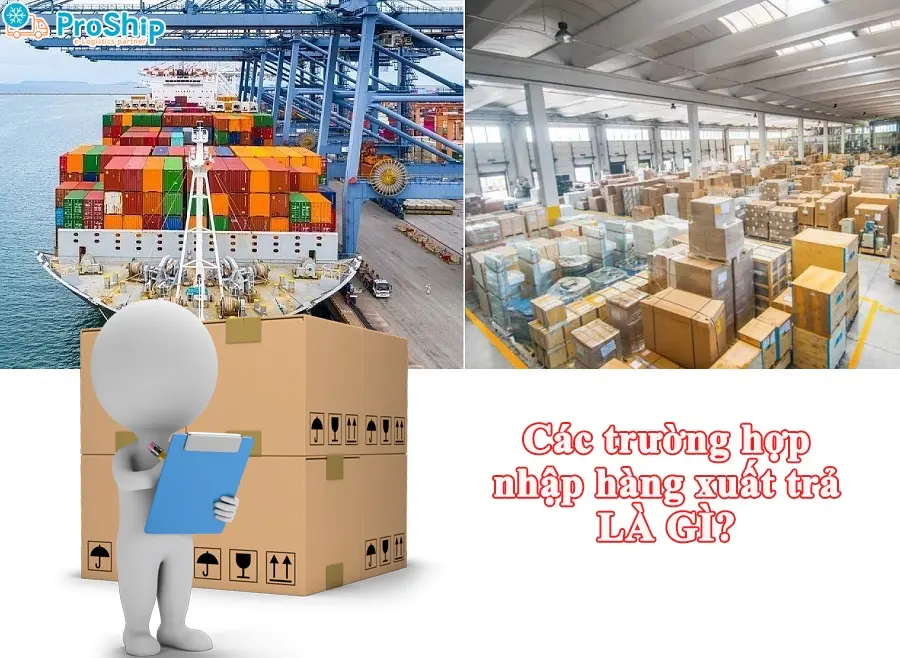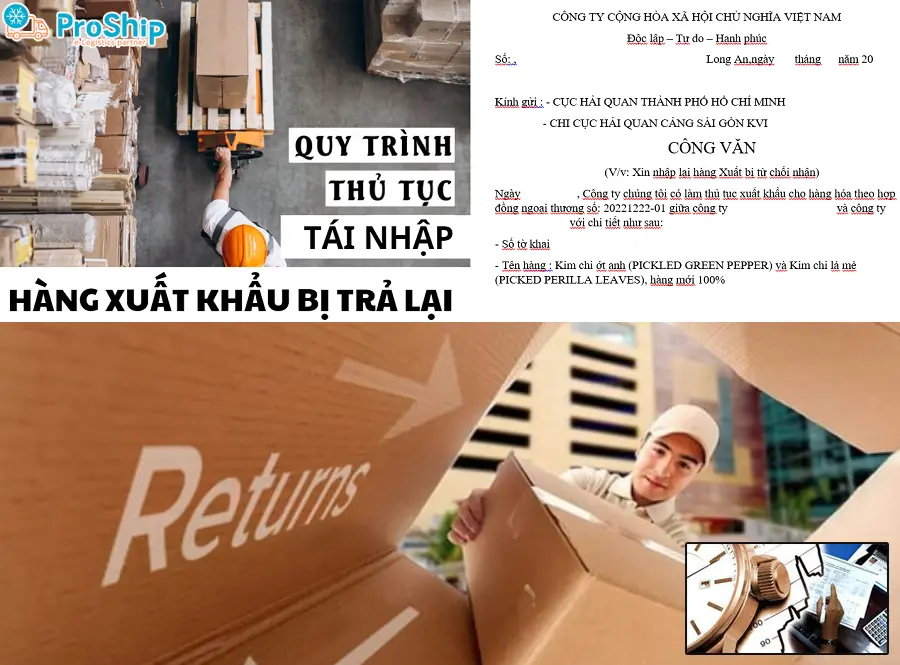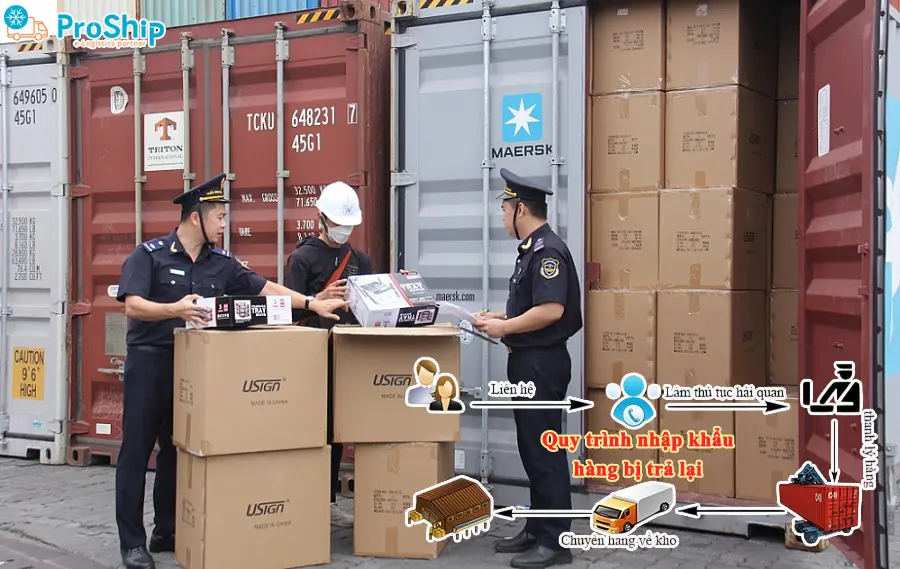Hàng hóa của bạn thuộc tiện tạm nhập tái xuất cần tìm hiểu hồ sơ, thủ tục nhập hàng xuất trả thế nào? Doanh nghiệp bạn đang gặp vướng mắc trong khâu làm thủ tục hải quan, khai tờ khai hải quan nên cần hiểu rõ chính sách nhập hàng xuất khẩu bị trả lại hiện nay quy định ra sao? Bạn thắc mắc liệu hàng hóa đã xuất khẩu nhưng bị trả lại có được tái nhập để tiêu thụ ở thị trường nội địa không?
Proship.vn chúng tôi sẽ giúp doanh nghiệp, chủ hàng biết được quy trình làm thủ tục nhập hàng xuất khẩu bị trả lại, hồ sơ hải quan cần chuẩn bị gồm những gì, các trường hợp nhập hàng xuất trả thường gặp,…cùng những lưu ý quan trọng khi tiến hành làm thủ tục nhập hàng xuất bị trả lại.
Nhập hàng xuất trả và các trường hợp cần biết
Sau đây là nguyên nhân dẫn tới tình trạng nhập hàng xuất trả và các trường hợp nhập hàng xuất trả mà Proship muốn giải đáp nhanh cho các chủ hàng:
Nhập hàng xuất trả
Hiện có nhiều nguyên nhân dẫn tới tình trạng hàng xuất bị trả lại như hàng không đạt chất lượng, người nhập khẩu từ chối nhận hàng, người nhập khẩu không thanh toán tiền hàng buộc phải tái nhập.
Làm thủ tục nhập hàng xuất khẩu bị trả lại là công việc đòi hỏi người nhập khẩu phải có kiến thức ngoại thương và am hiểu về pháp luật hải quan để tránh phát sinh thuế và phí nhập khẩu.
Các trường hợp nhập hàng xuất trả
Có hai trường hợp nhập hàng xuất trả được quy định rõ trong Quyết định 1357/QĐ-TCHQ ngày 18/05/2021:
- TH1: Nhập hàng để tiêu hủy hoặc tiêu thụ trong nước
Trường hợp này thường xuyên gặp phải trong thương mại quốc tế. Có nhiều nguyên nhân dẫn tới hàng hóa phải tái nhập như: Hàng hóa không đảm bảo chất lượng, người mua từ chối nhận hàng, hàng bị trả lại do không được phép nhập khẩu bởi quốc gia nhập và nhiều nguyên nhân khác nữa.
Mã loại hình nhập khẩu cho trường hợp này là A31

- TH2: Nhập hàng để sửa chữa, bảo dưỡng rồi tái xuất:
Là trường hợp gặp phải khi hàng không đạt chất lượng và bị người mua trả hàng về. Trường hợp này người nhập khẩu sẽ tạm nhập rồi sau đó sẽ tái xuất đi cho người bán hoặc cho bên thứ 3.
Mã loại hình nhập khẩu cho trường hợp này là: G13.
Thủ tục nhập hàng xuất khẩu bị trả lại cụ thể thế nào?
Quy trình, thủ tục nhập hàng xuất khẩu bị trả lại cụ thể như sau:
Chính sách nhập khẩu hàng xuất bị trả lại
Nhập khẩu hàng xuất bị trả lại được quy định trong các văn bản pháp luật sau:
- Thông tư 38/2015/TT-BTC ngày 25/3/2015 sửa đổi bổ sung 39/2018/TT-BTC ngày 20/04/2018;
- Nghị định 128/2020/NĐ-CP ngày 19/10/2020;
- Nghị định 69/2018/NĐ-CP ngày 15/05/2018.
Cần tuân thủ những điểm sau khi nhập khẩu hàng bị xuất tra lại:
- Hàng tái nhập không phải làm kiểm tra chuyên ngành nếu có;
- Hàng nhập khẩu phải đúng loại hàng trước khi đã xuất đi;
- Khi nhập khẩu sẽ không mất thuế nhập khẩu cho hàng đã xuất trước đó;
- Các mặt hàng cấm trong Nghị định 69/2018/NĐ-CP không được tái nhập;
- Hàng hóa tái nhập có hai dạng đó là nhập để tiêu thụ trong nước hoặc tiêu hủy và loại thứ hai đó là nhập để sửa chữa, bảo trì sau đó tiếp tục tái xuất.
Hàng hóa đã xuất khẩu nhưng bị trả lại có được tái nhập để tiêu thụ nội địa không?
Căn cứ khoản 1 Điều 47 Nghị định 08/2015/NĐ-CP quy định về thủ tục hải quan tái nhập đối với hàng hóa đã xuất khẩu như sau:
Thủ tục hải quan tái nhập đối với hàng hóa đã xuất khẩu
1. Các hình thức tái nhập hàng hóa đã xuất khẩu nhưng bị trả lại (sau đây gọi tắt là tái nhập hàng trả lại) bao gồm:
a) Tái nhập hàng trả lại để sửa chữa, tái chế (gọi chung là tái chế) sau đó tái xuất;
b) Tái nhập hàng trả lại để tiêu thụ nội địa;
c) Tái nhập hàng trả lại để tiêu hủy tại Việt Nam (không áp dụng đối với hàng gia công cho thương nhân nước ngoài);
d) Tái nhập hàng trả lại để tái xuất cho đối tác nước ngoài khác.
…
Theo quy định trên, trường hợp hàng hóa đã xuất khẩu nhưng bị trả lại thì CÓ THỂ TÁI NHẬP theo hình thức tái nhập hàng trả lại để tiêu thụ nội địa.

Hồ sơ hải quan tái nhập với hàng đã xuất khẩu gồm những gì?
Hồ sơ hải quan tái nhập đối với hàng hóa đã xuất khẩu được quy định tại khoản 2 Điều 47 Nghị định 08/2015/NĐ-CP như sau:
Thủ tục hải quan tái nhập đối với hàng hóa đã xuất khẩu
…
2. Hồ sơ hải quan:
a) Tờ khai hải quan hàng hóa nhập khẩu;
b) Chứng từ vận tải trong trường hợp hàng hóa vận chuyển bằng đường biển, đường hàng không, đường sắt: nộp 01 bản chụp;
c) Văn bản của bên nước ngoài thông báo hàng bị trả lại hoặc văn bản của hãng tàu/đại lý hãng tàu thông báo không có người nhận hàng: nộp 01 bản chụp.
3. Thủ tục hải quan thực hiện theo quy định tại Mục 5 Chương này (trừ giấy phép nhập khẩu, văn bản thông báo kết quả kiểm tra chuyên ngành).
4. Cơ quan hải quan không thu thuế đối với hàng hóa tái nhập quy định tại Khoản 1 Điều này, nếu tại thời điểm làm thủ tục tái nhập người khai hải quan nộp đủ bộ hồ sơ không thu thuế theo quy định.
5. Đối với hàng hóa tái nhập để tái chế thì thời hạn tái chế do doanh nghiệp đăng ký với cơ quan hải quan nhưng không quá 275 ngày kể từ ngày tái nhập; Người khai hải quan chưa phải nộp thuế trong thời hạn tái chế, nếu quá thời hạn tái chế đã đăng ký mà chưa tái xuất thì thực hiện theo quy định của pháp luật về thuế.
…
Lưu ý khi làm thủ tục tái nhập hàng xuất trả lại
Proship chỉ ra một vài lưu ý khi tiến hành tái nhập hàng xuất khẩu bị trả lại:
- Đưa ra quyết định nhanh khi hàng bị người bán trả lại không nên để hàng nằm lại quá lâu ở cảng dỡ hàng;
- Nhập khẩu hàng xuất khẩu bị trả lại không cần nộp thuế nhập khẩu;
- Nếu có thể bán được hàng cho bên thứ 3 thì bán luôn chấp nhận bán giá thấp;
- Tránh nhầm lẫn giữa G31 và A13;
- Có thể hoàn thuế xuất khẩu nếu đã đóng thuế xuất khẩu trước lúc xuất hàng.
Quy trình tiến hành nhập khẩu hàng bị trả lại
Quy trình làm thủ tục nhập hàng xuất khẩu bị trả lại được quy định cụ thể trong Thông tư 38/2015/TT-BTC ngày 25/3/2015 sửa đổi bổ sung 39/2018/TT-BTC ngày 20/04/2018:
Bước 1: Khai tờ khai hải quan
Sau khi có đủ chứng từ xuất nhập khẩu: Hợp đồng, Commercial invoice, Packing list, Vận đơn đường biển, Chứng nhận xuất xứ, Thông bảo hàng đến và xác định được mã HS hàng hóa thì nhập thông tin khai báo lên hệ thống hải quan qua phần mềm khai quan.
Bước 2: Mở tờ khai hải quan
Sau khi khai xong tờ khai hải quan, hệ thống hải quan sẽ trả về kết quả phân luồng tờ khai. Có luồng tờ khai thì in tờ khai ra và mang bộ hồ sơ nhập khẩu xuống chi cục hải quan để mở tờ khai.
Tùy tình trạng phân luồng xanh, vàng, đỏ mà thực hiện các bước mở tờ khai. Thông thường, nhập khẩu hàng xuất bị trả lại sẽ phải kiểm hóa hàng nhập khẩu.

Bước 3: Thông quan hàng hóa
Sau khi kiểm tra xong hồ sơ nếu không có thắc mắc gì thì cán bộ hải quan sẽ chấp nhận thông quan tờ khai. Lúc này có thể sẽ phải đóng thuế nhập khẩu cho tờ khai hải quan để thông quan hàng hóa.
Bước 4: Thanh lý tờ khai và nhận hàng
Sau khi tờ khai được thông quan thì lúc này có thể lấy tờ khai thông quan và mã vạch. Để gửi cho Công ty chuyển phát nhanh để tiến hành làm thủ tục lấy hàng và giao hàng.
Trên đây là thủ tục nhập hàng xuất khẩu bị trả lại mới chi tiết mà Proship muốn chia sẻ đến các chủ hàng, tư nhân, doanh nghiệp chuyên kinh doanh hàng xuất, hàng nhập có thể nắm rõ và áp dụng quy trình nhập khẩu hàng đúng quy định. Mọi thắc mắc liên quan, liên hệ ngay 0909 344 247 để được giải đáp và tư vấn trực tiếp các Dịch vụ vận chuyển hàng Đa phương thức trọn gói giá rẻ.

